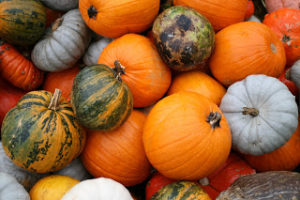
Photo of pumpkins, courtesy of Jeremy Seitz.
Fall is the time of year when pumpkins are plentiful! It is estimated that the United States produces 1.5 billion pounds of pumpkins every year!
Pumpkins are from the genus Cucurbita , which is part of the gourd family. Cucurbitas are native to North America; the first known evidence of pumpkins dates between 7000-5500 BC in the area today known as Mexico.
Pumpkins are a winter squash, which means they have a thick outer shell to help them last throughout the winter. This self-preserving quality has made the pumpkin a staple of the human diet. In addition, there are certain types of pumpkins that have naturally high sugar content. Commonly called “baking” or “sugar” pumpkins, these pumpkins are used to make pumpkin pie and other desserts.
Pumpkins come in all shapes, sizes, and colors. At maturity, there are some ornamental pumpkins that are small enough to fit in the palm of your hand, while there are other pumpkins that can weigh over 1,000 pounds! However, the most common pumpkin that most Americans recognize is a medium-sized, orange pumpkin that we carve around Halloween. This variety is called the Connecticut Field pumpkin.
As with most fruits, the pumpkin is not only valued for its flesh, but for its seeds. This year when you carve your pumpkin, try to save as many seeds as you can. You can use some for planting next year, or if you want to make a treat out of them, you can soak them in salt water and roast them in the oven.
For more information see: http://en.wikipedia.org/wiki/Pumpkin and http://en.wikipedia.org/wiki/Cucurbita
